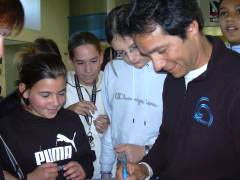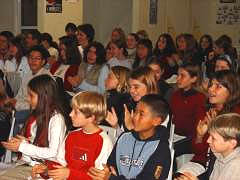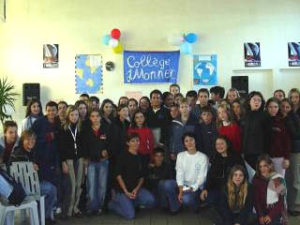2004
Home > Journals > 2004 – 2005: Vendée Globe
Ocean Planet Vendée Globe Update:
Friday, October 22, 2004
Below is the first of a series of special journals by Bruce that will be in addition to his regular updates. These journals will be sent out in coordination with special the Ocean Science Education Partnership with Bigelow Laboratory for Ocean Sciences. If you visit http://www.oceanplanet.org/, and www.bigelow.org/vendeeglobe, you will connect to Bigelow Labs wealth of Ocean Science education links.
We hope that you enjoy this great educational resource as we follow Bruce around the world in the epic Vendee Globe race!
Vendee Race Journal Number 1
What’s this all about? I will try to explain….
The Race:
The Vendee Globe happens every 4 years, and the 2004 race will be only the fifth time it has been held with this name. The first actual solo nonstop race around the world was the Golden Globe race, which started in England in the late 1960’s. Out of nine starters, only one sailor, Robin Knox-Johnston, finished the epic event.
It wasn’t until 1989 that another solo nonstop race was held. Named the Vendee Globe and starting from France, this race was organized by ocean racer Phillip Jeantot. He had a vision for a round-the-world race that would challenge sailors and their boats to the absolute limit. The first race saw 13 competitors line up for the start. Of that 13, only seven finished. Today, there are 20 skippers competing. By February 2005 a new chapter in racing history will be written — it is exciting to be a part of making that history happen!
What does it take?
An Open 60 racing boat is very complex, and you need to be familiar with a lot of systems and rigging to be able to operate these amazing machines. Even though I have sailed most of my life and have been solo racing since 1984, I have had to learn a lot over the past four years. Racing in the 2002/2003 Around Alone race was an important part of gaining the experience needed to sail non-stop around the world.
A Weighty Issue:
To get ready for The Vendee Globe 2004, I spent over a year on the coast of Maine working on Ocean Planet. I wanted to cut down the weight on the boat since so much more stuff comes onboard for the 3-4 month race. The lighter the boat, the more easily driven and the less of a load on sails, gear, and me. In the Around Alone, the boat weighed less than 20,000 pounds. Now, counting all the modifications she should be under well under 19,500 (before provisions come aboard). Part of the weight reduction is our new boom (about 75 pounds) and our new Cuben Fiber mainsail (not sure yet, but could be as much as 80 pounds lighter!).
Saving Energy:
Ocean Planet is very energy efficient, but we do burn a bit of power since the autopilot, radar, and computer are all on 24 hours a day. I have a diesel engine with two alternators but will also rely heavily on my new Solara MP solar panels. Racing non-stop at sea for 3-4 months makes it difficult to carry enough fuel for that length of time, so the panels will provide at least half of our power when the sun is out. Of course, when it is cloudy the diesel auxiliary is the main power, but it is amazing how well the Solara panels work. Another very special system is our water maker/desalinator. I use a Spectra water maker which is VERY efficient and draws only 5 amps at 24 volts while producing nearly 10 gallons per hour.
Rigging:
Ocean Planet has a very unique mast, as it is unstayed (no side stays) and rotating. This type of mast, which is a bit flexible and very hard to break, has much fewer parts and pins and is simpler in general than a standard mast. It is certainly getting a lot of attention here….and a lot of questions! But it is exactly the system that I want, and has already been around the world. Our new boom is about five feet shorter which will save weight (see above), be easier to use, and also safer. Our new “Cuben Fiber” mainsail will also save a lot of weight aloft which is a big gain in both performance and safety.
Navigation:
During the race, knowing exactly where you are and forecasting the weather is a big job. I will have a lot of tools to do this but it often takes 6hrs or more of analyzing each day in order to make the right decisions. For charting, I use all ‘digital’ charts, that is I feed GPS data to my laptop where I am running both Nobeltec navigation and seaPro racing software. Going online with our Iridium phone, I can download small weather data files (called “Grib” files) via the internet for areas that I specify with special software. Then I can display computer predicted weather maps on the PC for different time periods and even run little movies. But they are just computer predictions so one has to carefully look at them and of course the conditions that you ACTUALLY have on the boat. For instance, I have a very accurate barometer which helps to spots pressure trends and compare real-time data to the models so you decide how much faith to put in them.
I am busy in Les Sables for the next few weeks prepping all of the above before the race begins… But I hope this gives you a good idea about our boat and the adventure we are facing together in the Vendee Globe race! Join me, Ocean Planet, and Bigelow Laboratory for Ocean Sciences for over 26,000 ocean miles! You may be an ‘Ocean Expert’ by the time we finish….
Bruce from Les Sables d’Olonne, France.
Btw, yesterday I visited a local school here and met the students. Their enthusiasm was incredible! I’ve never signed so many autographs….



Bruce Schwab, Skipper
USA 05/Ocean Planet